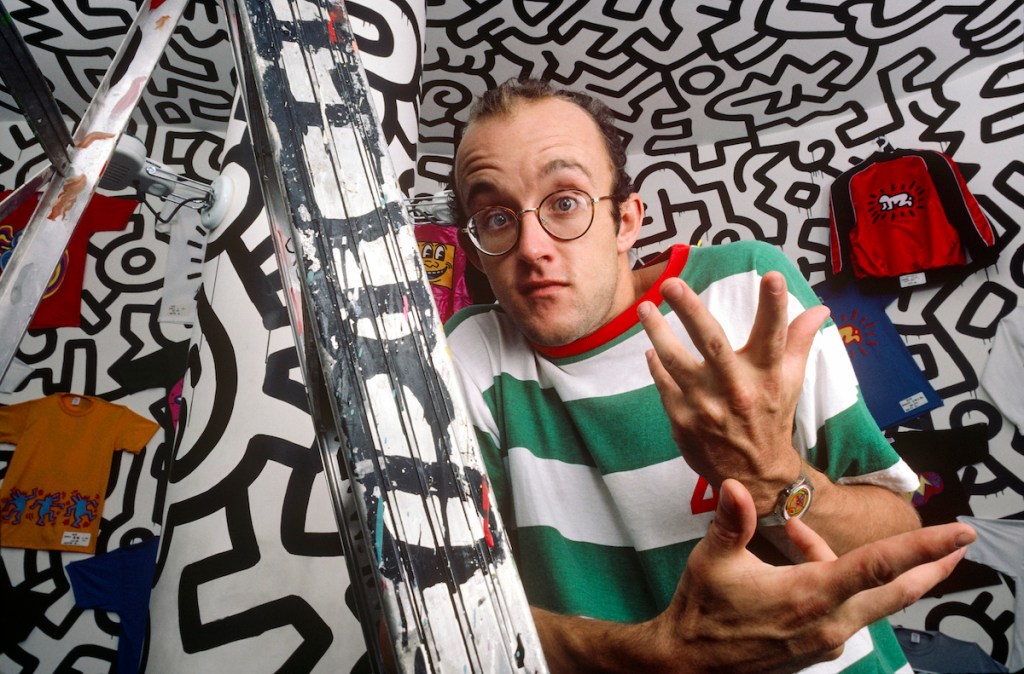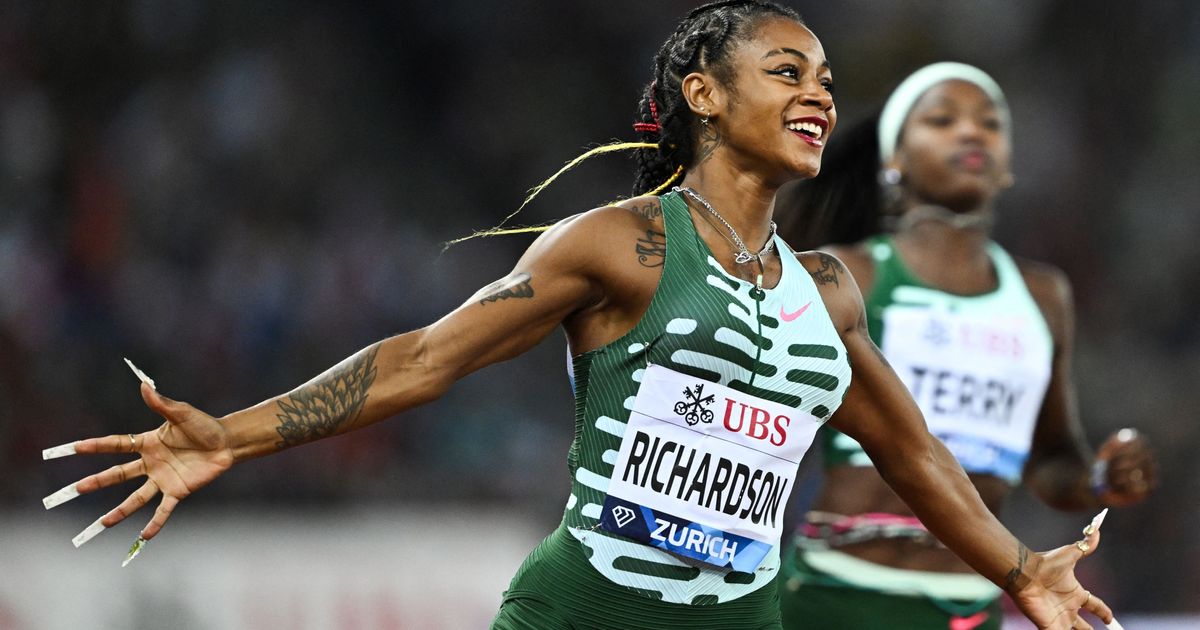Conjure an object in your head, and there’s a good chance you can purchase a version of it that is emblazoned with Keith Haring’s motifs.
You can buy a Uniqlo baseball hat with his “radiant baby” image ($29.90), a chess set from the MoMA Design Store whose pieces are all barking dogs and breakdancing figures ($55), high-top sneakers from Zara covered in Haring’s thick black lines ($25.99; on sale at the time of writing), and lounge pants from Urban Outfitters adorned with people with flowering heads ($45).
You can buy skateboards, stickers, and pins, all dotted with the same images that appear in Haring’s paintings. And from the design store at the Museum of Contemporary Art Los Angeles, you can even buy a Haring candle in a container with zigzagging stick figures all over it ($88). Per its description, when burned, the candle smells like lily of the valley, with notes of jasmine, peony, and musk.
There are few artists whose signature style has been so widely, unashamedly capitalized by big brands (with the help of estates and foundations). But in some ways, the condition is hardly new—Haring himself sold magnets, buttons, garments, coloring books, and skateboards at his very own Pop Shop, which launched in New York; for a time, he also ran a Tokyo outpost. The Japanese store became a problem when copycats began peddling shirts like his; it closed when the knockoffs became too tough to control, rendering Haring’s business obsolete. Money matters, after all.
The Pop Shop’s facade was spray-painted with the word CAPITALIST when it opened in New York in 1986—not that that necessarily kept members of the art world from flocking to it. Some observers were even more abrasive than the Pop Shop’s vandal. Writing in Spy magazine, journalist Tad Friend claimed that Haring’s art had reached a dead end with the Pop Shop, writing, “what precipitated Haring’s eclipse was not so much the suspicion that he had prostituted his art, but that he had nothing to prostitute.”
But was Haring really a sellout? This is the question that the writer Brad Gooch bandies about in his new Haring biography, Radiant: The Life and Line of Keith Haring (Harper), which makes the case that Haring’s art was conceptualism masquerading as capitalism.
The Haring we know is a graffiti artist-turned-art world superstar. Having made his name scrawling cryptic creatures on the walls of the New York subway system (and occasionally drawing legal penalties for doing so), he would within a decade end up exhibiting these inventions in paintings that sold for vast sums in blue-chip European galleries. It was a tough balancing act for Haring, who once retorted, “I don’t know what they intended me to do: Just stay in the subway the rest of my life? Somehow that would have made me pure?”

Keith Haring’s recent exhibition at the Broad in Los Angeles featured items from the Pop Shop.
Photo Dania Maxwell/Los Angeles Times via Getty Images
Well, would it have? Gooch invests himself in rebutting the notion that Haring was impure simply because he profited from his art. He quotes KAWS, an artist known for selling his own array of collectibles: “It almost seems like a natural thing these days to be an artist and make products.” The implication is that Haring simply opened the door for others to follow. And in the book’s final chapter, Gooch approvingly quotes American actor and filmmaker Dennis Hopper’s eulogy for Haring, given at his funeral in 1990, the year Haring died of AIDS-related causes at the tender age of 31. Hopper credited Haring with “bringing back the ideals of conceptual art” by spinning the stuff of the everyday into works galleries could show and sell.
And sell, they did. Haring came of artistic maturity in the ’80s New York scene, a milieu that was suddenly flush with money as the art market rapidly expanded. (He got his start in the more hardscrabble and less monied East Village, and then graduated beyond it.) Haring, as Gooch reports, had at the start of the decade vowed never to sell a painting for more than $10,000. By the end of his life, one of his paintings sold at an AIDS charity auction for seven times that figure.
In Radiant, the painter George Condo, who befriended Haring, recalls that, at one point in his career, Haring consciously decided to “change his ways from being relatively humble to exploiting the potential of what you can do when you make a few bucks as an artist.” Gooch seems to ask if you can blame him.
The desire to make money always lay dormant within Haring. Born in 1958 in Reading, Pennsylvania, Haring was raised in the unassuming suburb of Kutztown; his family’s home exuded a “middle-class respectability,” according to one local publication. Haring had the ambition to exceed that town. “When I grow up,” a fourth-grade Haring wrote, “I would like to be an artist in France. The reason is because I like to draw. I would get my money from the pictures I would sell. I hope I will be one.”
His early reference to financial fortune seems telling: not every aspiring artist dreams of a creative lifestyle and a healthy cash flow. But during the 1970s, when he attended a Pennsylvania art school with a focus on work made to suit commercial purposes, he came to the realization that he “wasn’t going to be a commercial artist.” He just didn’t have the chops for it, he thought. Little did he know.

By the time he came to New York to study at the School of Visual Arts in 1978, he was working in what Gooch describes as an “Alechinsky-meets-Dubuffet manner,” a reference to Pierre Alechinsky and Jean Dubuffet, two European avant-gardists. These painters worked in a faux naive style that deliberately appeared sloppy and loose, like a child’s approach to a grade-school art assignment. Gooch digs into the influence Haring drew from both, in particular Dubuffet for his “sympathy for the influences of Eastern art, especially calligraphy, in which drawing is a kind of writing and writing a kind of drawing.” If you follow Gooch’s logic, no sellout would fall so hard for art that so vastly differed from what Westerners want. Perhaps for that reason, Haring’s stardom did not arrive overnight.
Gooch’s descriptions of Haring’s poverty during this era are evocative. He writes of one of Haring’s early living spaces, an East Village residence that was actually part of a “lady’s apartment subdivided into small, unattractive rooms she leased mostly to much older men, one of whom died while Haring was living there, with everyone sharing a kitchen and bathroom.” It was certainly nothing like his final apartment, “a duplex penthouse in a six-story condominium building with ten raw loft spaces.” Haring paid $600,000 for that residence.
Yet while he initially hustled to make ends meet, he also found he didn’t have to suffer forever. During the early ’80s, Haring helped organize art exhibitions for the Mudd Club, a chic boîte in the East Village, but as he grew increasingly skeptical of management there, he parted ways and started selling his drawings himself. “I realized I could probably start living from my work,” Haring said. “I also realized I didn’t ever have to do menial work again. And so, I quit.” Later, he would work with dealer Tony Shafrazi, who priced his paintings at $30,000 a pop.

Andy Warhol and Keith Haring, 1984.
Paul Bruinooge/Patrick McMullan via Getty Images
In the ensuing several hundred pages, Gooch charts Haring’s social rise, pointing out the time that he consulted Andy Warhol for business advice and the times he hung out with Madonna. Gooch adopts a defensive posture regarding Haring’s fame, writing that he was “unaware that he was as famous as some of the celebrities he was eager to catch a glimpse of or speak with.” This seems sort of hard to believe, given that Haring put so much work into cultivating a friendship with Warhol and even leaned heavily on the Pop artist’s own social network for clout. (Warhol, for his part, was impressed by some but not all of Haring’s art. Of the Pop Shop, Warhol disparagingly wrote in his diary, “So I guess he is a little like Peter Max.”)
For Haring, fame was twinned with fortune, and the confluence of the two blinded him to the realities of those he kept close. Radiant does not elide descriptions of behavior by Haring that now seem queasy at best and racist at worse.
His Pop Shop was staffed mainly by “cute, young Latin boys,” as one of Haring’s colleagues recalls—ostensibly as a means of differentiating its workforce from the ones seen at department stores of the era, but really to add intrigue for white visitors. Haring’s lovers also tended to be Latino; one ex, Juan Rivera, claims that Haring had a “rivalry” with Madonna that was based around “street-looking Latino boys.”
One walks away with the sense that Haring exoticized these Latino men because it added value to his life and art. But this is not something Gooch presses too hard, since his point, mainly, is to show that Haring’s gleeful commercialism was intentional. It’s places like these where the book fails to rebut the notion that Haring’s concessions to the whims of capitalism served a larger purpose.
As described in Radiant, the differences between Haring and his Black and Latino colleagues are stark. Rivera narrates a party held at the Whitney Museum where the painter Jean-Michel Basquiat drew away from the festivities while Haring reveled in them. “Jean-Michel would lock himself in the bathroom,” Rivera says, “and Keith would have to go spook him out, and he’d be like, ‘this party, man, and these people—they are just not my style.’”
Rivera leaves it unclear which party he’s describing. Gooch believes it was one held in 1986 to celebrate a collaboration between Haring and Absolut vodka—yet another example of how he had monetized his art, allegedly in the name of avant-garde radicalism. The party may not have been Basquiat’s style, but as Gooch makes clear, it certainly was Haring’s. It was loud, brash, and exciting. And it was sponsored by a big-name brand too.


